Kent (pop. 1,576,069) is the county in southeastern England known as the garden of England because of its beautiful countryside. It is especially known for the blossom of its many orchards in the springtime and for its hop fields. Kent has two cathedrals, in Canterbury and Rochester. Canterbury Cathedral was the scene of one of the most famous murders in British history. Four knights killed Thomas Becket, archbishop of Canterbury, in the cathedral in 1170. Afterwards, Becket was canonized (made a saint) and many pilgrims visited his shrine.
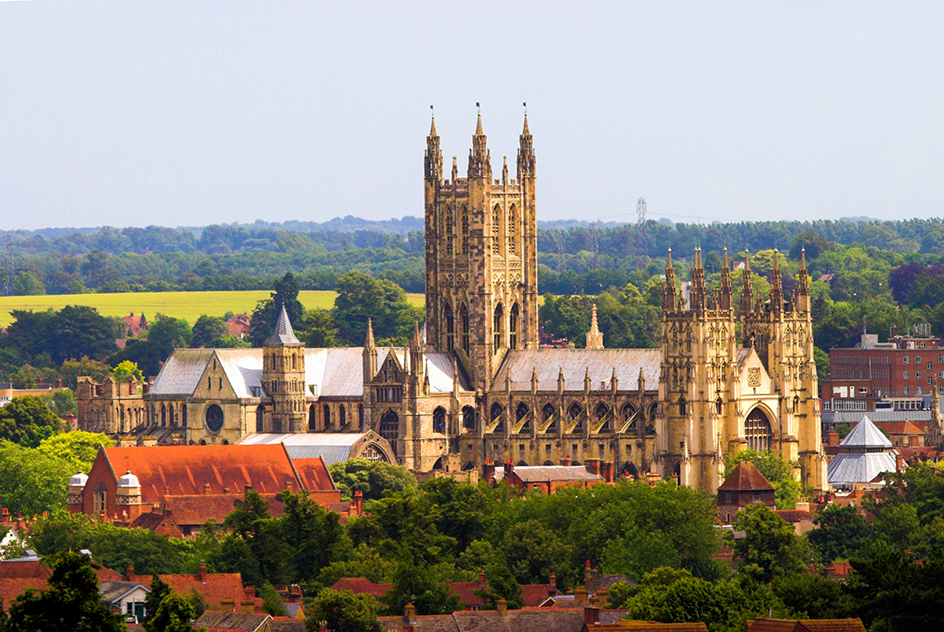
Kent covers an area of 1,368 square miles (3,544 square kilometers). Its administrative center is Maidstone.
People and government.
A famous Kent custom is distribution of Biddenden Dole on Easter Monday. The custom started on the death of Mary and Eliza Chulkhurst, conjoined twins born about the year 1100. In their estate, they left 8 hectares of land as a source of regular income for an annual dole of bread and cheese for poor people. Each year the dole is distributed from the window of an old cottage, built on land that once belonged to the twins. Hard biscuits, known as Biddenden cakes, are given to onlookers. Each cake has stamped on it the date 1100 and figures of the twins.
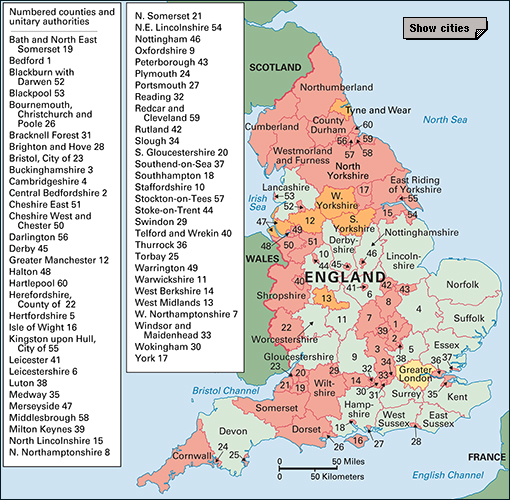
Canterbury still keeps its ancient custom of sounding the curfew. Each evening the bell is sounded from Bell Harry Tower in the cathedral. William the Conqueror introduced the curfew during the 1000’s.
Cricket has been popular in Kent for more than 200 years. Canterbury’s Cricket Week, the first week of August, is one of the county’s major sporting events. During the week, a number of events and entertainments are staged in addition to the cricket games involving the county team. Well-known golf courses in the county are at Sandwich and Deal. The county also has some unusual sports. Canterbury people still play an ancient game called bat and trap. A batsman has to hit a ball between posts about 13 feet (4 meters) apart.
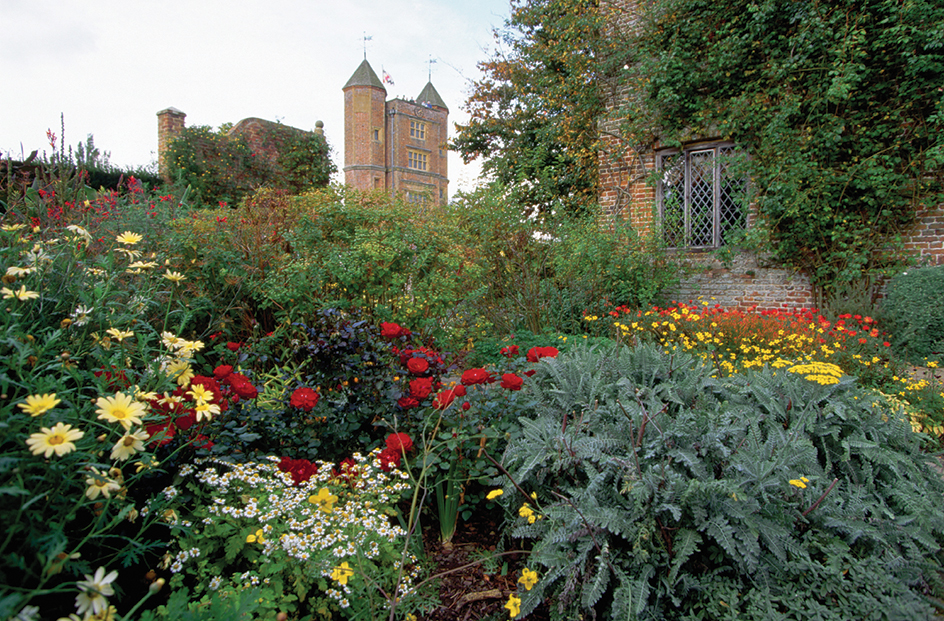
All activities connected with coastal areas are popular. Kent has beautiful beaches, excellent bathing, and many opportunities for fishing. Rowing and sailing are popular, and a number of towns have regattas. There is a horse-racing course at Folkestone. Motor racing events take place at Brands Hatch.
Kent is divided into 12 local government districts. They are Ashford, which includes Ashford and Tenterden; Canterbury, which includes Canterbury, Herne Bay, and Whitstable; Dartford, which includes Dartford and Swanscombe; Dover, including Deal, Dover, and Sandwich; Folkestone and Hythe, which includes Folkestone, Hythe, and New Romney; Gravesham, which includes Gravesend and Northfleet; Maidstone; Sevenoaks, which includes most of the western edge of the county; Swale, which includes Faversham, Isle of Sheppey, and Sittingbourne; Thanet, which includes Broadstairs, Margate, and Ramsgate; Tonbridge and Malling; and Tunbridge Wells. Kent County Council, which has headquarters at Maidstone, provides some public services throughout the county. In 1998, the two districts of Gillingham and Rochester upon Medway became a separate unitary authority called Medway, with all local government powers within its boundaries.
The crown court sits at Canterbury and Maidstone. Kent County Constabulary, the local police force, has its headquarters at Maidstone.
Economy.
Kent has an important papermaking industry. All kinds of paper are produced, including writing paper, newsprint, and paper used for money. Other products of Kent’s factories include beer, bricks, cement, chemicals, clothing, explosives, flour, and oil products.
Apple and cherry orchards cover large areas in Kent. Other important fruit crops include blackberries, currants, gooseberries, loganberries, raspberries, and strawberries. Hop fields also cover large areas. The most important hop-growing area is the Vale of Kent, east of Tonbridge. Important grain crops are barley, oats, and wheat. In eastern Kent, farmers grow root crops on the light chalky soil. Some farmers grow lucerne (alfalfa) for animal fodder. Truck farmers in northern Kent grow vegetables for sale in London.
Kent has more sheep compared with its area than any other English county. Some farmers keep sheep on Romney Marsh in the summer. In the winter, they move the sheep to the drier pastures of the North Downs. Dairy farming has become increasingly important in Kent. Romney Marsh now has dairy cattle. It also produces flowers, potatoes, strawberries, and wheat.
Some coastal towns have fishing industries. Whitstable is known for its oysters.
Canterbury is one of the United Kingdom’s leading tourist centers and attracts many overseas visitors. Its cathedral attracts pilgrims and sightseers. People in the coastal towns depend greatly on tourism. Resorts range from quiet Broadstairs to lively Margate, which has a large amusement park.
Kent has important road and rail routes for goods and passengers traveling between the United Kingdom and continental Europe. Folkestone is the British terminal for the Channel Tunnel, an undersea rail link connecting the United Kingdom with France, which opened in 1994. The Channel Tunnel forms part of a high-speed rail network linking the United Kingdom with major European cities.
Dover has boat services to various French and Belgian ports and hovercraft services to Boulogne and Calais, in France. Another hovercraft service links Ramsgate and Calais. Folkestone has boat services to Boulogne and Calais. Passenger ferries also operate between Sheerness and the Dutch port of Flushing. Kent International Airport is near Ramsgate.
Land.
Kent is bordered by the estuary of the River Thames and Medway Unitary Authority on the north, the Strait of Dover on the east, East Sussex on the south, and Surrey and London on the west. Low-lying areas of clay, sand, and silt cover most of the land that lies along the Thames estuary in northern Kent. The Isle of Grain in the Thames estuary is no longer an actual island. Silt has filled the creeks that once separated the area from the mainland.
To the east of the Isle of Grain, the Swale–a channel that is filled with water at high tide–separates the Isle of Sheppey from the mainland. The Isle of Thanet is a chalk area in northeastern Kent.
The North Downs, a chalk upland, extend across the county. They end at the coast, where they form the white cliffs of the Strait of Dover. The Weald, an area of clays and sandstones, lies between the North Downs in Kent and the South Downs in East Sussex.
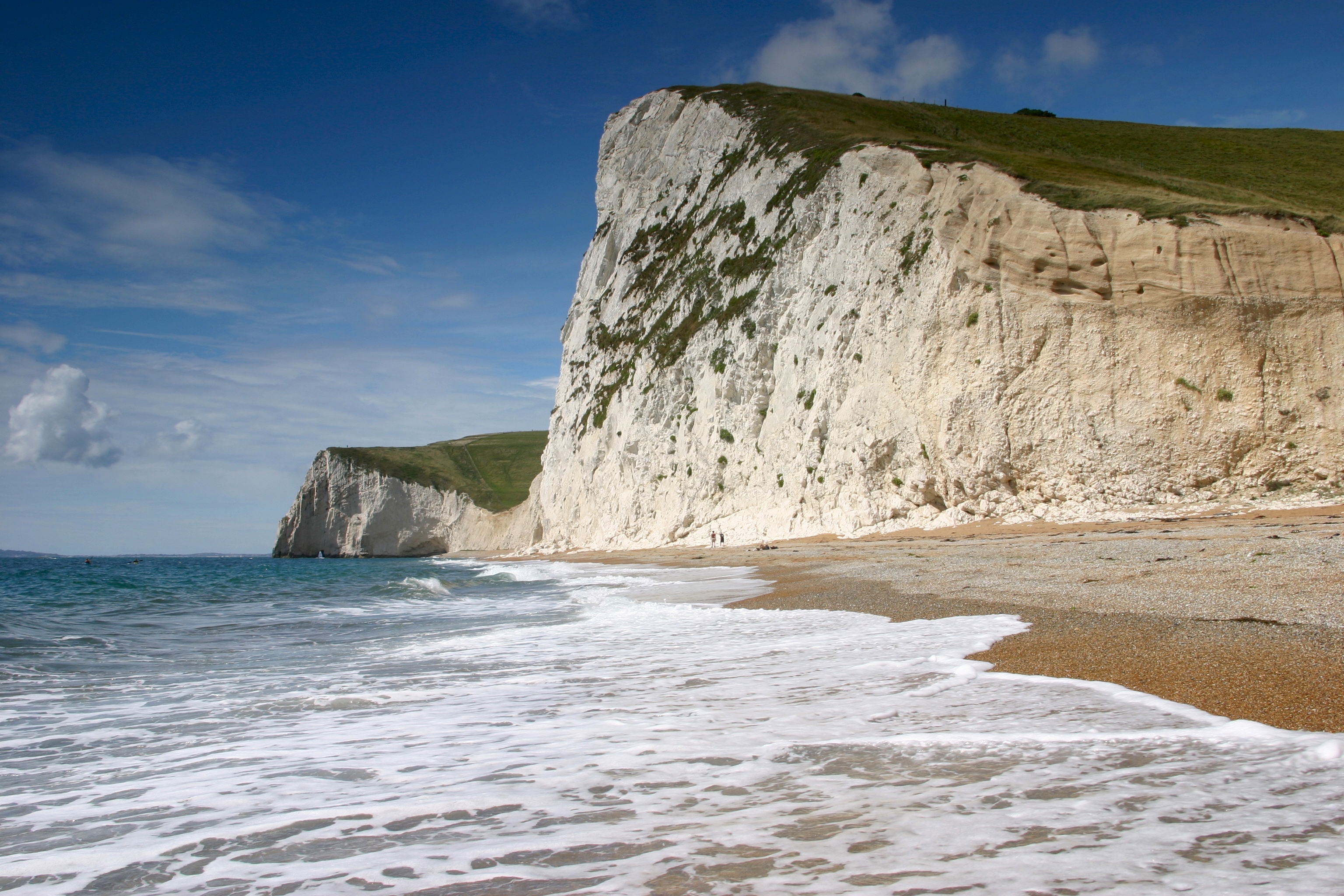
The most important river in Kent is the River Medway, which rises in the center of the Weald and flows into the Thames estuary.
History.
Julius Caesar landed at Deal in Kent in 55 B.C. In A.D. 43, the Romans again landed in Kent and occupied it. The Saxons attacked Kent in the A.D. 200’s. After the Romans left Britain, Saxon attacks continued. According to some medieval accounts, which may be partly legendary, a king of Kent named Vortigern appealed to the Jutes for assistance. Hengist, a Jutish chieftain, and his brother Horsa, landed in Kent in 449. Later, they rebelled and Hengist became king.
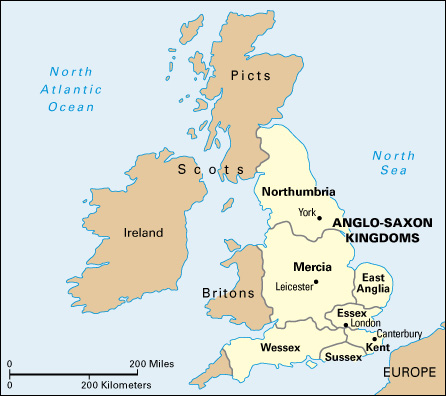
Historians consider that Ethelbert, also spelled Aethelberht, was the most important king of Kent. During Ethelbert’s reign, Saint Augustine landed in Thanet in 597. Ethelbert gave Saint Augustine a church in Canterbury. In the 600’s, Kent became one of the seven main kingdoms of Anglo-Saxon England.
After the Norman conquest in 1066, many castles and churches were built in Kent. At the time of the Napoleonic wars, many defensive positions were established in Kent. The Royal Military Canal, which bounds Romney Marsh in the north, was constructed as a defense work in the early 1800’s. In World War II, soldiers who had been evacuated from Dunkerque in 1940 landed at ports in Kent. German bombers damaged many towns in the county.
Under the London Government Act of 1963, Kent’s boundary with London was changed. The county lost about 5 per cent of its surface area and about 30 per cent of its population. The area that was formerly Kent consists of the London boroughs of Bexley and Bromley. Kent was relatively little affected by England’s local government reorganization in 1974. But Canterbury, which had been independently governed as a county borough, became an integral part of the county.
Kent has many historical and literary associations. Well-known people born in Kent include William Caxton, who introduced printing into England; the dramatist Christopher Marlowe; and General James Wolfe, the victorious general in the Battle of Quebec. The English author Charles Dickens often visited Kent and spent the last years of his life at his home there, where he died in 1870. The English actress Ellen Terry had a country house in Kent and died there in 1928.
